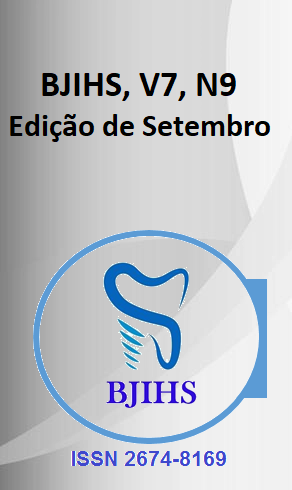Abstract
INTRODUCTION: Acute Kidney Injury (AKI) is a clinical syndrome characterized by a sudden and potentially reversible loss of renal function, being highly prevalent among hospitalized patients, especially those admitted to Intensive Care Units (ICUs). This condition is associated with increased mortality, prolonged hospital stays, and higher healthcare costs. Although classifications such as RIFLE, AKIN, and KDIGO have standardized diagnostic criteria, underreporting remains frequent and compromises clinical management.OBJECTIVES:To review the current scientific literature on Acute Kidney Injury, highlighting risk factors, diagnostic classifications, emerging biomarkers, therapeutic strategies, and prognostic implications.METHODOLOGY:This study consists of a literature review carried out between 2019 and 2024 in the PubMed, SciELO, and LILACS databases. Articles in Portuguese, English, and Spanish were included if they were available in full text and addressed prevalence, diagnosis, treatment, or clinical outcomes of AKI. Studies not directly related to the topic or with low methodological relevance were exclude. RESULTS:The analysis showed that sepsis, hypoperfusion, nephrotoxic drugs, and urinary tract obstruction are the main triggers of AKI. Approximately 70% of patients present partial or total recovery of renal function within 90 days, while 30% progress to chronic kidney disease or require renal replacement therapy. Non-pharmacological strategies, such as infection prevention, hemodynamic optimization, and reduction of nephrotoxic exposure, proved to be essential for prognosis. Biomarkers such as NGAL and KIM-1 are emerging as promising tools for early diagnosis, although they are not yet widely available in clinical practice. CONCLUSION:
AKI remains a major clinical challenge due to its high incidence and prognostic impact. The literature reinforces the need for preventive strategies, standardized clinical protocols, and multiprofessional training. Furthermore, diagnostic advances, such as biomarkers, and therapeutic approaches, such as individualized renal replacement therapy, hold the potential to improve survival and quality of life in affected patients.
References
Sesso R, et al. Doença renal crônica, inflamação e aterosclerose: novos conceitos de um velho problema. Rev Assoc Med Bras. 2007;53(5):446-51. doi:10.1590/S0104-42302007000500022.
Barroso FF, et al. Conhecimento da população sobre a doença renal crônica, seus fatores de risco e meios de prevenção: um estudo de base populacional em Fortaleza, Ceará, Brasil. J Bras Nefrol. 2022;44(4):413-22. doi:10.1590/2175-8239-JBN-2022-0017pt.
Granda CM, et al. Occupational risks associated with chronic kidney disease of non-traditional origin (CKDnt) in Brazil: it is time to dig deeper into a neglected problem. J Bras Nefrol. 2023;45(2):179-92. doi:10.1590/2175-8239-JBN-2023-0123en.
Pinheiro HS, et al. Smartphone and application use in self-management of chronic disease: a cross-sectional feasibility study. Sao Paulo Med J. 2022;140(6):698-705. doi:10.1590/1516-3180.2022.0078.R2.09082022.
Francis A, et al. Chronic kidney disease and the global public health agenda: an international consensus. Nat Rev Nephrol. 2024;20(7):473-85. doi:10.1038/s41581-024-00820-6.
Shlipak MG, et al. The case for early identification and intervention of chronic kidney disease: conclusions from a KDIGO Controversies Conference. Kidney Int. 2021;99(1):34-47. doi:10.1016/j.kint.2020.10.012.
Santos L, et al. Impacto do exercício físico em pacientes com doença renal crônica: revisão sistemática e meta-análise. Nefrología. 2020;40(4):378-89. doi:10.1016/j.nefro.2020.01.002.
Silva AC, et al. Identificando fatores de risco para desenvolvimento de Doença Renal Crônica entre escolares. J Bras Nefrol. 2012;34(1):47-54. doi:10.5935/0101-2800.20120010.
Aguiar LK, et al. Fatores associados à doença renal crônica: inquérito epidemiológico da Pesquisa Nacional de Saúde. Rev Bras Epidemiol. 2020;23:e200044. doi:10.1590/1980-549720200044.
Costa CK, et al. Overview of global healthcare policies for patients with chronic kidney disease: an integrative literature overview. Einstein (Sao Paulo). 2022;20:eRW6518. doi:10.1590/1980-5497202206518.

This work is licensed under a Creative Commons Attribution 4.0 International License.
Copyright (c) 2025 Letícia Rodrigues Babinsck, daniel Ruiz agum, Emilly da Silva Dela Costa, Maria Nogueira da Costa, Ana Carolina Franskoviak Cunha Silva, Juliana Machado Sopeletto, Alice Sales zampirolli, Maria Clara Cosseti Gava, Angélica Pimenta do Amaral, Maria de Moraes Guarçoni Silva Brito, Giovana Figueira Barbosa, Anitha Coelho Barbosa, Leandro Mendes Zagotto
